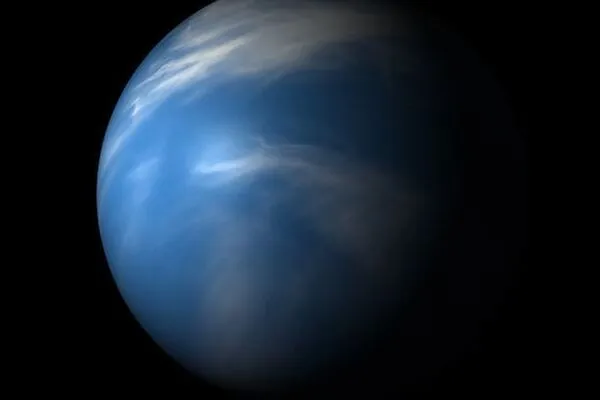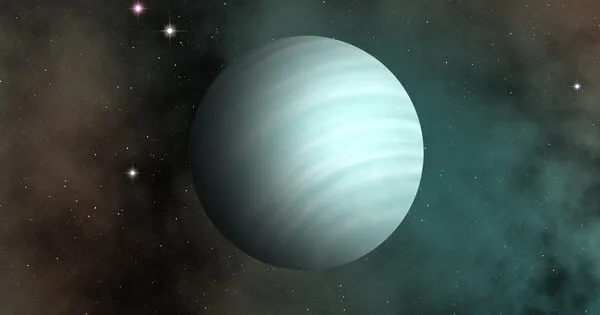Measuring the light emitted by the atmosphere of a sub-Neptune planet can reveal important details about its composition and physical properties. Researchers typically use spectroscopy to study the light emitted by such a planet.
The atmosphere of exoplanet GJ 1214b was studied by measuring the heat it emits while orbiting its host star. The light emitted by a sub-Neptune exoplanet – a category of planets larger than Earth but smaller than Neptune – was directly detected by astronomers.
Astronomers have been trying to get a better look at GJ 1214b, an exoplanet 40 light-years away from Earth, for over a decade. The thick layer of haze that blankets the planet shields it from the probing eyes of space telescopes and stymies efforts to study its atmosphere.
That problem was solved by NASA’s new James Webb Space Telescope (JWST). The infrared technology of the telescope enables it to see planetary objects and features that were previously obscured by hazes, clouds, or space dust, assisting astronomers in their search for habitable planets and early galaxies.
JWST operates at longer wavelengths of light than previous observatories, which gives us access to the heat emitted by the planet and allows us to create a map of the planet’s temperature. We finally got to see GJ 1214b in a new light.
Eliza Kempton
JWST was used by a team of researchers to observe GJ 1214b’s atmosphere by measuring the heat it emits while orbiting its host star. Their findings, which will be published in the journal Nature on May 10, 2023, are the first direct detection of light emitted by a sub-Neptune exoplanet – a category of planets larger than Earth but smaller than Neptune.
Despite the fact that GJ 1214b is far too hot to be habitable, researchers discovered that its atmosphere contains water vapor, possibly in significant amounts, and is primarily composed of molecules heavier than hydrogen. Eliza Kempton, lead author of the Nature study and Associate Professor of Astronomy at the University of Maryland, said their findings mark a watershed moment in the study of sub-Neptune planets like GJ 1214b.
“I’ve been on a quest to understand GJ 1214b for more than a decade,” Kempton said. “When we received the data for this Nature paper, we could see the light from the planet just disappear when it went behind its host star. That had never before been seen for this planet or for any other planet of its class, so JWST is really delivering on its promise.”

Researchers measure the light emitted by a sub-Neptune planet’s atmosphere
A ‘new light’
Although none exist in our solar system, sub-Neptunes are the most common type of planet in the Milky Way. Despite the murkiness of GJ 1214b’s atmosphere, Kempton and her co-authors determined that the planet’s bright but small host star gave them the best chance of observing a sub-Neptune’s atmosphere.
The researchers measured the infrared light emitted by GJ 1214b over the course of about 40 hours – the time it takes the planet to orbit its star. The amount of heat that shifts from one side of a planet to the other as day turns to night is largely determined by the composition of its atmosphere. Known as a phase curve observation, this research method opened a new window into the planet’s atmosphere.
“JWST operates at longer wavelengths of light than previous observatories, which gives us access to the heat emitted by the planet and allows us to create a map of the planet’s temperature,” Kempton said. “We finally got to see GJ 1214b in a new light.”
By measuring the movement and fluctuation of heat, the researchers determined that GJ 1214b does not have an atmosphere dominated by hydrogen.
Potential water world?
Astronomers have long been curious about whether GJ 1214b contains water. Previous Hubble Space Telescope observations suggested that GJ 1214b could be a water world, a loose term for any planet with a significant amount of water.
The most recent JWST data revealed traces of water, methane, or a combination of the two. These substances correspond to a subtle light absorption seen in the wavelength range observed by JWST. More research is needed to determine the exact composition of the planet’s atmosphere, according to Kempton, but the evidence remains consistent with the possibility of large amounts of water.
“GJ 1214b, based on our observations, could be a water world,” Kempton said. “We think we detect water vapor, but it’s challenging because water vapor absorption overlaps with methane absorption, so we can’t say 100% that we detected water vapor and not methane. However, we see this evidence on both hemispheres of the planet, which heightens our confidence that there really is water there.”





